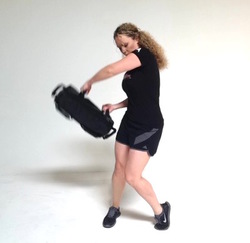The Perfect Core Sandbag Shoulder Squat
2015-02-8

Jessica Bento, Physical Therapist (Creator DVRT Restoration, Pelvic Girdle Course, and DVRT Shoulder Restoration)
Is a squat a squat is a squat?
Don’t worry, this isn’t something goofy riddle, but something that I don’t think enough people ask themselves. For so long we have been concerned with just getting people to squat well that we stopped looking at what makes various squats different and produce different effects.
One in particular is our DVRT Ultimate Sandbag Training Shoulder Squat. I know, the Shoulder Squat has long been thought of an exercise where you just heave a weight on your shoulder and just squat. Unfortunately, that is also what has made this type of squat a passing novelty in most fitness programs rather the staple it deserves!
The primary and unsung benefit of the DVRT Ultimate Sandbag Training Shoulder Squat is the fact it is a multi-planar exercises. Very simply, we try to move up and down and try to resist the forces pulling us laterally and in rotation. A really great Shoulder Squat looks like our body is evenly loaded even though we obviously have weight on just one side of the body. The Shoulder Squat is one of the VERY best exercises in evaluating whether or not someone really has good core stability.
I know, we aren’t on the ground, we aren’t blowing up our abs, so how is the Shoulder Squat so great? As I have talked about in past DVRT Ultimate Sandbag Training posts, the core isn’t just your abs, your low back, not even just your hips. Rather ALL the muscles that surround the pelvis, the nice mirror abdominal muscles as well as the deep ones you can’t see, the lats, fascia, and muscles on the back. In other words, there are a lot of different parts of your body that try to stabilize your spine during movement.
It makes sense then we would want to evaluate your core stability in something you are more likely to use, both standing and squatting.
The problem is that most people don’t think of the Shoulder Squat this way and miss some of the BIG things that make this such an essential DVRT Ultimate Sandbag Training exercise.
Stance
You have to know first and foremost, people won’t know, or feel the compensations they make. How they stand is an easy one. A lot of people will not have their feet lined up squarely and/or they may have one leg out to the side more than the other.

Foot shift is VERY common and people won’t know they even did it! Use a line in the ground for some feedback or even a dowel rod to know if you are shifting.

Some will even move one leg out further from the midline causing a hip shift typically to the side of the weight.
Once we get the feet right then we can watch the DVRT Ultimate Sandbag Training Shoulder Squat. It is important to know that I am not going to ask you to pull out the tape measure or anything. All of the issues I am discussing should be easy to identify with a quick check of the eyes.

In a good Shoulder Squat the body should look even and you should notice no to very minimal shift of the hips.

In a lot of Shoulder Squats you will see the hips shift to one side (typically to the side of the weight) and you will see it appears as though one knee is further away from the torso. A clear sign we have some instability in the core.
Because of the complexity of the Shoulder Squat (there are a lot of parts of the body working) we aren’t diagnosing, rather evaluating. Firstly, are we using an appropriate weight of Ultimate Sandbag. If you are compensating then simply try to lower the weight. If we attempt this and still see the compensations then we may have to address some specific needs which I will write about later this week. The first step is to build awareness in knowing what is right and wrong in such powerful exercises. Lateral stability is one of THE most powerful qualities we can create in our fitness programs to increase our functional strength, resiliency to injury, and overall movement skills.
The Shoulder Squat is a great example of one of the classic misunderstandings of “sandbag training”. Many people would say the reason the Shoulder Squat is so difficult is because of the shifting weight of the Ultimate Sandbag. We have instability, but NOT because of the movement of the Ultimate Sandbag, rather because of the placement of the load. That is why understanding our DVRT principles are so important. If you know WHY things work then you can progress them and use them to their full extent!
Try using these tips and see how you do performing the DVRT Ultimate Sandbag Training Shoulder Squat!
Save 25% all throughout DVRT with coupon code “save25” like our DVRT Online Education HERE and our Ultimate Sandbags HERE
© 2024 Ultimate Sandbag Training. Site by Jennifer Web Design.






